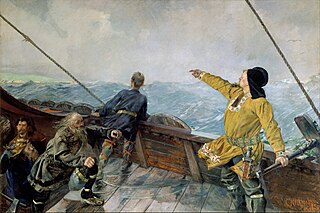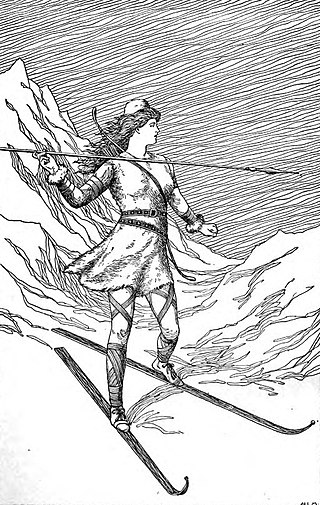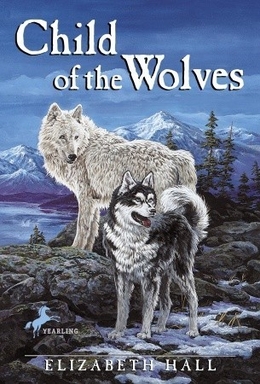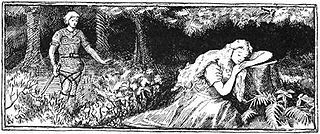Related Research Articles
In Norse mythology, Ginnungagap is the primordial, magical void mentioned in three poems from the Poetic Edda and the Gylfaginning, the Eddaic text recording Norse cosmogony.

Vinland, Vineland, or Winland was an area of coastal North America explored by Vikings. Leif Eriksson landed there around 1000 AD, nearly five centuries before the voyages of Christopher Columbus and John Cabot. The name appears in the Vinland Sagas, and describes Newfoundland and the Gulf of Saint Lawrence as far as northeastern New Brunswick. Much of the geographical content of the sagas corresponds to present-day knowledge of transatlantic travel and North America.

In Norse mythology, Skaði is a jötunn and goddess associated with bowhunting, skiing, winter, and mountains. Skaði is attested in the Poetic Edda, compiled in the 13th century from earlier traditional sources; the Prose Edda and in Heimskringla, written in the 13th century by Snorri Sturluson, and in the works of skalds.

The Norsemen were a North Germanic linguistic group of the Early Middle Ages, during which they spoke the Old Norse language. The language belongs to the North Germanic branch of the Indo-European languages and is the predecessor of the modern Germanic languages of Scandinavia. During the late eighth century, Scandinavians embarked on a large-scale expansion in all directions, giving rise to the Viking Age. In English-language scholarship since the 19th century, Norse seafaring traders, settlers and warriors have commonly been referred to as Vikings. Historians of Anglo-Saxon England distinguish between Norse Vikings (Norsemen) from Norway, who mainly invaded and occupied the islands north and north-west of Britain, as well as Ireland and western Britain, and Danish Vikings, who principally invaded and occupied eastern Britain.

Freydís Eiríksdóttir was an Icelandic woman said to be the daughter of Erik the Red, who figured prominently in the Norse exploration of North America as an early colonist of Vinland, while her brother, Leif Erikson, is credited in early histories of the region with the first European contact. The medieval and primary sources that mention Freydís are the two Vinland sagas: the Saga of the Greenlanders and the Saga of Erik the Red. The two sagas offer differing accounts, though Freydís is portrayed in both as a strong woman.

Ynglinga saga is a Kings' saga, originally written in Old Norse by the Icelandic poet and historian Snorri Sturluson about 1225. It is the first section of his Heimskringla. It was first translated into English and published in 1844 by Samuel Laing.
Gudrid Thorbjarnardóttir was an Icelandic explorer, born at Laugarbrekka in Snæfellsnes, Iceland.

The Saga of Erik the Red, in Old Norse: Eiríks saga rauða, is an Icelandic saga on the Norse exploration of North America. The original saga is thought to have been written in the 13th century. It is preserved in somewhat different versions in two manuscripts: Hauksbók and Skálholtsbók.

Grottasǫngr is an Old Norse poem, sometimes counted among the poems of the Poetic Edda as it appears in manuscripts that are later than the Codex Regius. The tradition is also preserved in one of the manuscripts of Snorri Sturluson's Prose Edda along with some explanation of its context.
Snorri Thorfinnsson most likely born between 1004 and 1013, and died c. 1090) was the son of explorers Thorfinn Karlsefni and Gudrid Thorbjarnardóttir. He is considered to be the first child of European descent to be born in the Americas, apart from Greenland. He became an important figure in the Christianisation of Iceland.

Thorfinn Karlsefni Thórdarson was an Icelandic explorer. Around the year 1010, he followed Leif Eriksson's route to Vinland in a short-lived attempt to establish a permanent settlement there with his wife Gudrid Thorbjarnardóttir and their followers.

Grœnlendinga saga is one of the sagas of Icelanders. Like the Saga of Erik the Red, it is one of the two main sources on the Norse colonization of North America. The saga recounts events that purportedly happened around 1000 and is preserved only in the late 14th century Flateyjarbók manuscript.

Hyrrokkin is a female jötunn in Norse mythology. According to 13th-century poet Snorri Sturluson, she launched the largest of all ships at Baldr's funeral after the Æsir gods were unable to budge the vessel.

Dogsbody is a 1975 children's novel by British writer Diana Wynne Jones, first published by Macmillan. It tells the story of Sirius, a star who is forced to live in the body of a dog on Earth. The book was Wynne Jones' fifth full-length novel.

The Ice-Shirt is a 1990 historical novel by American author William T. Vollmann. It is the first book in a seven-book series called Seven Dreams: A Book of North American Landscapes.

Child of the Wolves is a children's novel, published in 1996, about a Siberian husky puppy that joins a wolf pack. It was written by Elizabeth Hall, wife of Island of the Blue Dolphins author, Scott O'Dell.

Skáldskaparmál is the second part of the Prose Edda, compiled by Snorri Sturluson. It consists of a dialogue between Ægir, the divine personification of the sea, and Bragi, the god of poetry, in which both stories of the Æsir and discourse on the nature of poetry are intertwined. The work additionally includes tales of human heroes and kings. The overarching mythological setup gradually fades and the work becomes more of an early form of a poetic thesaurus of Old Norse, presumably intended for usage by skalds. Much of the work is focused on poetic phrases and descriptors. The origin of these kennings is given; Bragi delivers a systematic list of kennings for various Æsir, people, places, and things. He then goes on to discuss poetic language in some detail, in particular heiti, essentially poetic synonyms or alternate words. For example, the simple hestr, "horse", might be replaced by jór, "steed".
Maria is the title given to a Filipino version of Cinderella collected by Fletcher Gardner and published in The Journal of American Folklore, in 1906. The story is related both to the international Cinderella narrative, as well as to the motif of the calumniated wife.
References
- ↑ French, Jackie (March 2007). Rover by Jackie French. HarperCollins. ISBN 978-0-06-085079-1 . Retrieved 14 February 2024.
{{cite book}}:|website=ignored (help)